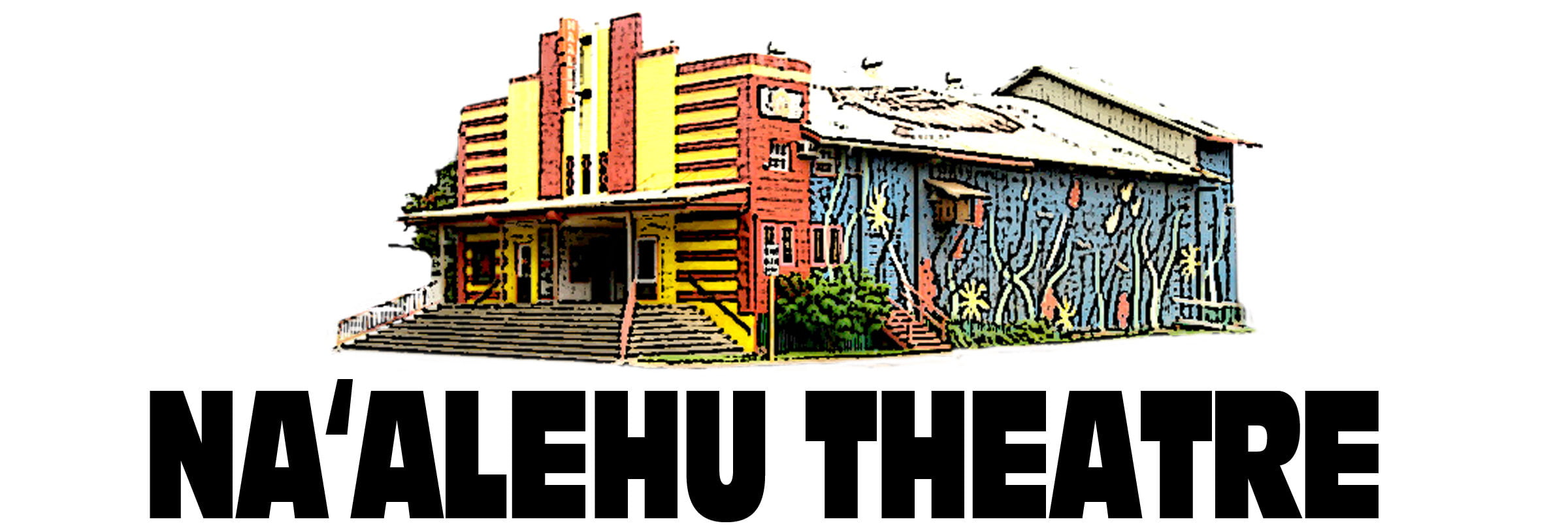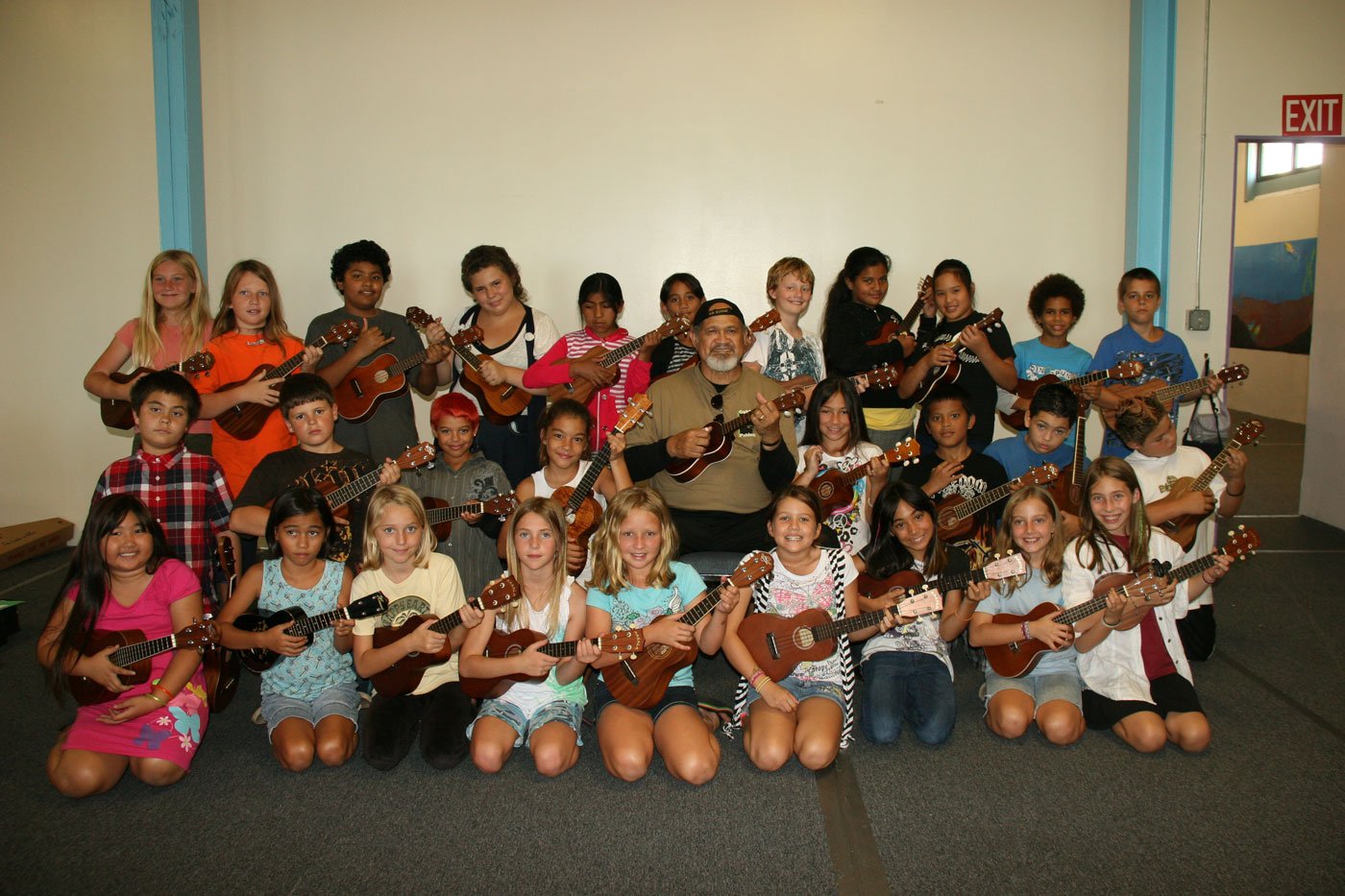 Music instruction in our programs is based in traditional methods and mentorship. Music instruction is grounded in the values and traditions that make up the Native Hawaiian approach to learning. It utilizes the same method and teaching strategies that most of the instructors in our programs learned from.
Music instruction in our programs is based in traditional methods and mentorship. Music instruction is grounded in the values and traditions that make up the Native Hawaiian approach to learning. It utilizes the same method and teaching strategies that most of the instructors in our programs learned from.
What We Do
Nā‘ālehu Theatre provides free music instruction and mentorships to elementary school students who wouldn’t otherwise have access to lessons. Students in our programs receive weekly instruction from Hawaiian music masters in ‘ukulele, steel guitar, slack-key guitar, and vocals.
The program initiated by George Lanakilakeikiahiali‘i Na‘ope, began in 1995 at the historic theatre in Nā‘ālehu. Ka‘u as a way to bring music instruction to at-risk youth in this remote, isolated community. It has grown significantly since, and has impacted more than 5,000 of Hawai‘i’s youth on every island.
Students in our programs have an opportunity to share their hard work with their families and community at community performances and school hōʻike and at our annual Gabby Pahinui Waimānalo Kanikapila. At these performances, students play along-side master instructors and other well-known professional Hawaiian musicians.
Nā‘ālehu Theatre provides in-school concerts and performances for students at no charge throughout the year.
Our program also provides after school and summer music workshops for youth and their families in rural communities taught by award-winning instructors.
Method
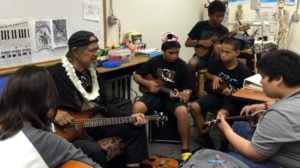 Nānā ka maka; hoʻolohe ka pepeiao; paʻa ka waha. (Observe with the eyes; listen with the ears; shut the mouth.) from ʻŌlelo Noʻeau, Hawaiian Proverbs and Poetical Sayings by Mary Kawena Pukui
Nānā ka maka; hoʻolohe ka pepeiao; paʻa ka waha. (Observe with the eyes; listen with the ears; shut the mouth.) from ʻŌlelo Noʻeau, Hawaiian Proverbs and Poetical Sayings by Mary Kawena Pukui
The Native Hawaiian approach to learning is based on the ʻōlelo noʻeau, or wise sayings, about the Hawaiian worldview and values, as well as lessons in behavior, protocol, relationships, land management, arts, and spirituality.
The following sayings make up the Hawaiian approach to learning:
Nānā ka maka (The eye sees)
For the learner: Observe the task to be done
For the teacher: Model or demonstrate the task
Hoʻolohe ka pepeiao (The ear listens)
For the learner: Listen to the instructions and any other sounds that clarify the task (wind, rain, ocean, or materials being used)
For the teacher: Not all instruction is with words
Paʻa ka waha (Secure/shut/fasten the mouth)
For the learner: Be silent and process the two steps above
For the teacher: This is the critical thinking stage
Hana ka lima (Put the hands to work)
For the learner: Learn by doing; mimic the teacher’s work
For the teacher: Observe and check the student’s work
Nīnau (Question)
For the learner: Questions may be asked only after the previous steps have been done at least one more time; twice is ideal
For the teacher: Send the learner back to the previous steps again to self-correct/learn by doing
Instructors
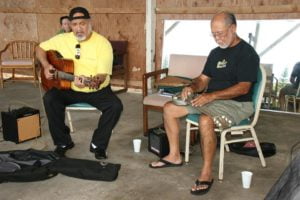 We provide excellent musician instructors, who are also high-caliber professionals, well known for their contributions to Hawaiian music and who learned by traditional methods and teach in the traditional style that has sustained cultural integrity and preservation of music traditions. Instructors have included Cyril Pahinui, Dennis Kamakahi, Palani Vaughan, Kawika Kahiapo, Sonny Lim, Greg Sardinha, Peter Wook Moon, Jeff Au Hoy, and Pomaika‘i Keawe Lyman.
We provide excellent musician instructors, who are also high-caliber professionals, well known for their contributions to Hawaiian music and who learned by traditional methods and teach in the traditional style that has sustained cultural integrity and preservation of music traditions. Instructors have included Cyril Pahinui, Dennis Kamakahi, Palani Vaughan, Kawika Kahiapo, Sonny Lim, Greg Sardinha, Peter Wook Moon, Jeff Au Hoy, and Pomaika‘i Keawe Lyman.
In addition to learning music theory and comprehension, instructors equip students with strong foundational skills in Hawaiian music style. Students are provided with opportunities for performance to ensure they can effectively apply their newfound skills and knowledge and build self-esteem and pride in their accomplishments. Several performances are scheduled annually at schools and community festivals and events where students perform alongside their kumu (master instructors).
Instruments
‘Ukulele,
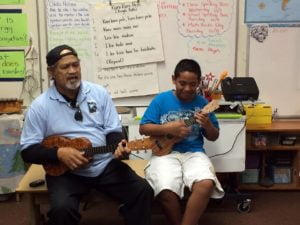 The ‘ukulele originated in the 19th century as a Hawaiian adaptation of the Portuguese machete, a small guitar-like instrument introduced to Hawai‘i by Portuguese immigrants. The name ‘ukulele roughly translates as “jumping flea”
The ‘ukulele originated in the 19th century as a Hawaiian adaptation of the Portuguese machete, a small guitar-like instrument introduced to Hawai‘i by Portuguese immigrants. The name ‘ukulele roughly translates as “jumping flea”
The tone and volume of the instrument vary with size and construction. ‘Ukuleles commonly come in four sizes: soprano; concert; tenor; and baritone.
One of the most important factors in establishing the ‘ukulele in Hawaiian music and culture was the ardent support and promotion of the instrument by King David Kalākaua. A patron of the arts, he made it an official instrument of the Hawaiian Kingdom and incorporated it into performances at royal gatherings.
During the 1970s, new manufacturers began producing ‘ukuleles, and a new generation of popular musicians, led by Peter Moon and Isreal Kamakawiwa‘ole, took up the instrument and helped to re-popularize it.
Kīkā kila, the Hawaiian Steel Guitar
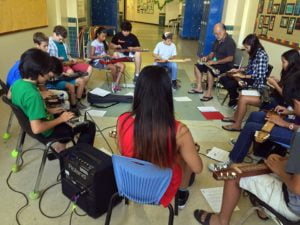 Kīkā kila, the Hawaiian steel guitar, refers to a type of guitar or the method of playing the instrument.
Kīkā kila, the Hawaiian steel guitar, refers to a type of guitar or the method of playing the instrument.
Developed in Hawai‘i by Joseph Kekuku‘upena-kana‘iaupunio Kamehameha Apuakehau in the late 19th and early 20th centuries, a steel guitar is usually positioned horizontally; strings are plucked with one hand, while the other hand changes the pitch of one or more strings with the use of a bar or slide called a steel (generally made of metal, but also of glass or other materials).
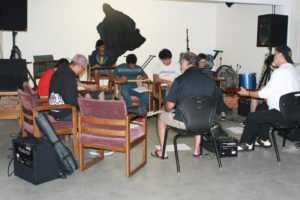 The electrified steel guitar was first made in the early 1930s by Bob Dunn’s western swing band from Texas and was later picked up by country western musicians in the 1940s and early 1950s. Gabby Pahinui’s mastery of the instrument solidified the steel guitar’s popularity with a new generation of Hawaiian musicians.
The electrified steel guitar was first made in the early 1930s by Bob Dunn’s western swing band from Texas and was later picked up by country western musicians in the 1940s and early 1950s. Gabby Pahinui’s mastery of the instrument solidified the steel guitar’s popularity with a new generation of Hawaiian musicians.
Kī hōʻalu, Hawaiian slack-key
Kī hōʻalu, Hawaiian slack-key, refers to an open tuning guitar style rooted in nearly two centuries of Hawaiian history. The English term is a translation of the Hawaiian kī hōʻalu, which means “loosen the [or tuning] key”. It is achieved by detuning or “slacking” one or more of the strings until the six strings form a single chord, frequently such as C major. The style originated from Mexican cowboys in the late 19th century. These paniolo (a Hawaiianization of españoles—”Spaniards”) brought guitars to Hawai‘i, taught the Hawaiians the rudiments of playing, and then left, allowing the Hawaiians to develop the style on their own.
In the old days, there was an almost mystical reverence for those who understood kī hōʻalu, and the ability to play it was regarded as a special gift. Families held their own styles of tuning secret and passed them on from generation to generation. A more open spirit prevails today, and many of the best guitarists openly share their tuning styles.
Gabby Pahinui and the Pahinui ‘ohana nui made a significant contribution to its current popularity and world-wide recognition.
Creating a Music Learning Environment
Students in our music programs have access to quality instruments and other teaching materials as well as close mentorship and engaging learning environments that foster excitement about music. Students have access to carefully designed materials and quality instruments that are accessible and well maintained.
We envision a place where all Hawai‘i’s youth have opportunities to learn directly from today’s masters and then carry on the traditions of Hawaiian music to generations who follow.
Bold Goals
The Hawaiian Music Masters’ Program invests in nearly 1,000 youth each year and aims to invest in at least 5,000 annually by 2020.
Support
Our Hawaiian Music Masters’ Program is supported through visitor industry and other donations, small to medium-sized grants, fundraising activities, and generously donated time and resources from Hawai‘i’s music industry community and musician volunteers.
Building Sustainable Relationships
Parents, schools, industry and government partners create a supportive environment for music both at home and in school
We collaborate with local governments, schools, communities, and families to ensure they understand the importance of music education and how we can play a supporting role in enabling students to achieve more of their potential.
Beyond Classroom Walls
We use evidence of our impacts in schools to advocate adoption of our approach to music. Communities are transformed through a stronger education system that ensures that music and the arts are included in every child’s educational experience.
We work in partnership with the music industry and government to develop and drive reforms in music curriculum, teacher training, and music promotions.
Measuring Outcomes
Tracking our progress and outcomes has been an essential part of our project since the beginning. We are committed to putting data at the heart of an evidence-based program design and holding ourselves accountable not just to our supporters but most importantly to the youth and families we serve.
Turning Data Into Action
We are committed to conducting high-quality research that gives us objective and accurate answers to program performance. We measure music progress as well as life skills, focus on how we are doing and ways we can improve the quality and effectiveness of our programs.
Our Hawaiian Music Masters’ Program uses an adaptation of the Rochester Evaluation of Asset Development for Youth (READY) tool as an instrument designed to help youth-serving programs evaluate their impact on participants. The instrument consists of 40 items that measure the four core youth development outcomes, along with program participation, connectedness to program, socio-demographics and changes to Hawaiian cultural awareness.
Place-Based Learning
He Huaka‘i e Pana na i ke Ea— A Journey to Bring Pulse to the Living
Eō nā Wahi Pana o Hawaiʻi
(Answer, you celebrated places of Hawaiʻi)
He Huaka‘i E Pana Na I Ke Ea – Hawaiian Place-based Learning
Hawaiian place-based learning looks at the ‘aina (land) and local environment from a native perspective to study how it has been used over time, modern land use issues, and the relationships among place, history, culture, and traditions.
One of the programs inspired and designed by the late Uncle George Lanakilakeikiahiali‘i Naope is the series of workshops called He Huaka‘i E Pana Na I Ke Ea — A Journey to Bring Pulse to the Living, a traveling succession of instruction where training focuses on mele wahi pana, the chants, songs, music, and hula of treasured regions or sites. In a culture where traditions are kept and passed orally, chants, songs, and dances are an archive of ideology, connections, memories, and experiences from Hawaiian ancestors. The intention of this program is to ground and reconnect students with the life of the land and the traditional knowledge it endows.
“He ali’i no ka ‘aina, ke kaua wale ke kanaka.” ~’Olelo Hawai’i
“The land is the chief, the people merely servants.” ~Hawaiian Proverb
As a young boy, Uncle George was taken to each site referenced in a chant or mele he was learning to reflect on its environmental nuances and historic significance. As a kumu (master instructor), he insisted that his students take the time to experience for themselves the slope of the pali (cliff) or the sting of the rain at a particular-locale to gain a deeper understanding and better execute the intrinsic motions of a dance. He taught that underlying the traditions of nā hula is the concept of mana, or spiritual power, a world linked to the elements, where one can speak directly to the winds or the rain and expect an answer.
Also essential to Uncle George’s teaching was the focus on understanding the three different levels of the oral language used in a Hawaiian composition: the literal; the kaona, or hidden meanings woven into the obvious, and the noa huna, or spiritual level, where spoken words have the power to cause action, including life and death.
In addition to music and dance training, the He Huaka‘i program provides participants with a unique, enriching, and authentic quality cultural experience; to present insight into the history, customs, art, traditions, and significant context; to offer close-up interaction with the community and its resource people; to increase familiarity with treasured sites; and to encourage aloha ‘āina, an ingrained respect for the land, and mālama ‘āina, a desire to preserve, protect, and take care of the precious resources of the land. Students begin the He Huaka‘i project by mapping hundreds of chants and songs to sites throughout the Hawaiian Islands, and then moving through that map, each year locating in another district, where the chants, music, and hula of that region are featured and taught.
In 2005, Master of Hawaiian music, Cyril Pahinui, a lifelong friend of Uncle George, was asked to lead a series of workshops by selecting musicians and cultural resource people to share their knowledge and experience of the selected local sites. The series began in Ka‘ū, a vast, rural, and remote area on the Island of Hawai‘i, home to most of the Hawai‘i Volcanoes National Park, which includes Kīlauea, home to the Hawaiian volcano goddess, Pele, and one of the world’s most active volcanoes, a place of natural wonders where one can witness the creation of the islands. It has since traveled to wai pana throughout the Hawaiian Islands and most recently in Waimānalo where it continues with the Hawaiian Music Master’s Program and Ho‘ike A‘o Kanikapila (recital).
